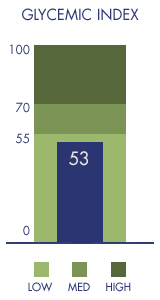In a recent test by Glycemic Index Laboratories, Inc., Wild Blueberries scored 53 on the Glycemic Index (GI) scale making them a low GI food. Consuming low GI foods causes a smaller rise in blood glucose levels than consuming high GI foods — an important consideration for people with diabetes.
What is the Glycemic Index?
 The Glycemic Index ranks carbohydrate foods according to their effect on the body’s blood glucose levels. Individual foods are compared to white bread or glucose and ranked on a 100-point scale, with white bread at 100. A GI of 70 or more is high; 56 to 69 medium; 55 or less low. At the high end of the scale are crackers and corn flakes; at the low end are non-starchy vegetables, fruits, beans, sugars and most dairy products. Glycemic values may differ from person to person and can be affected by factors such as ripeness, cooking procedures, processing techniques and food combinations.
The Glycemic Index ranks carbohydrate foods according to their effect on the body’s blood glucose levels. Individual foods are compared to white bread or glucose and ranked on a 100-point scale, with white bread at 100. A GI of 70 or more is high; 56 to 69 medium; 55 or less low. At the high end of the scale are crackers and corn flakes; at the low end are non-starchy vegetables, fruits, beans, sugars and most dairy products. Glycemic values may differ from person to person and can be affected by factors such as ripeness, cooking procedures, processing techniques and food combinations.
The Glycemic Load
Even more useful than a food’s GI value is its Glycemic Load (GL), according to Wild Blueberry Association Nutrition Advisor Kitty Broiher, MS, RD, LD. Glycemic Load measures both the type and quantity of carbohydrate consumed, which tell you how rapidly a particular carbohydrate turns into sugar, as well as how much of that carbohydrate a particular food contains. A GL of 20 or more is high, 11 to 19 medium, and 10 or less low. Blueberries have a low GL with one-half cup or 100g measuring 6.5.
Why Glycemic Measurements are Important
Understanding the glycemic values of food makes healthy meal planning easier — especially for people with diabetes. Nutrition experts are also interested in the effect GI foods may have on weight loss and appetite control. Research is currently under way to evaluate these claims.





